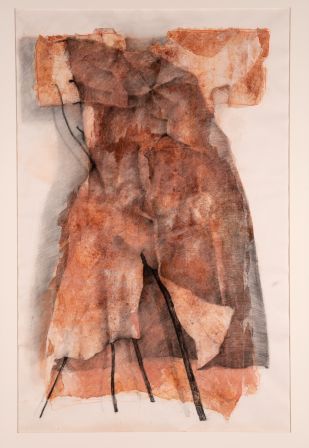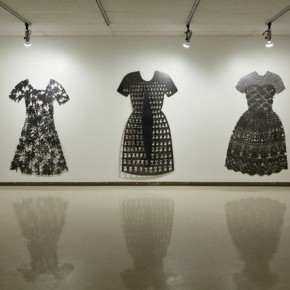Editor’s note: This review of Earth Skins at Mount Saint Vincent University Art Gallery (Halifax, NS, August 23 – October 2, 2011) first appeared in the Spring 2012 issue of Visual Arts News. A retrospective publication of Earth Skins can be purchased here.

Susan Wood, “Dress No. 1,” 1989, dry pigment, watercolour, pastel, carbon, washi collage on paper 199.4 x 129.5 cm (irregular), Collection of The Rooms Provincial Art Gallery
I was the first visitor to wander into to Earth Skins: Three Decades of Drawing by Susan Wood mid-afternoon on August 23. I am particularly fond of Wood’s ability to capture flux, complexity and beauty with textured, at times messy, (oh the joy of coffee stains and blotting paper — real life! Imagine!) technically brilliant drawings of flowers, insects and dead birds. She layers skin-thin Washi paper, collaging it to a thick watercolour paper base and drawing over it, adding texture and dimension. Her obvious love of the materials she works with and absolute love for the process is simply inspirational.
Wood’s older works are very large: These are the “Devils Purse” and “Dress” series, executed between 1985 and 1990. I had never seen them before and found them very powerful. Over six-feet high, they hang frameless on the walls of the gallery. They are in the space with the viewer, as opposed to separated and protected by a pane of glass and the strange ghostly reflections that obscure the work. One might even venture to say that they are active in a way — one says paper relaxes, that paper breaths. Wood’s desire to have the material unfettered, unrestricted and accessible makes me draw connections to British sculptor Rose Garrard and her sensibility to the elements preventing or insulating the viewer from being touched by art.
Under glass or not, the graphic punch of these series will not be denied. The pieces blow you over as you enter the space. Looking at her renderings of shadows is coming into contact with honed observational and technical skills. There is obvious delight in this creation of depth. In both series Wood uses stand-ins (skate egg sack and a dress) for women’s bodies. The viewer is led to empathize with and relate to these forms from the inside out, bypassing the voyeuristic gaze that objectifies. It is for me a reversal of sorts, a re-empowerment also. Margaret Atwood, in an essay included in Dropped Threads, discusses working from the earth on up in contrast to from theory down, to ensure vitality and potency. This is how I experience Wood’s works — a validation without any confining definition of the corporeal experience of being a woman.
Wood works in charcoal, watercolour, conte and ink. Made of coal, burnt and raw umber, rust and sanguine, her pallette is punctuated periodically in later years with a flash of ochre or vermillion and lends itself well to these explorations of body. I understood each dress drawing as a meditation on one aspect of the bodily experience of being a woman. There is a sense of a procession through stages, cycles and ordeals — each tied into the glorious muck-andguck veins, organs, sex, flesh, sinew and bone, that make our bodies. It takes a certain kind or courage and bravery to embrace all that we are, to be curious about discomfort (about body hair for example) or the edges of pain. I perceive Wood’s art process as grounded in the experiential, sensual feminine, as a combination of intuitive representation and deliberate mirroring of life cycles and processes.
Susan Wood’s work has a quality of practice to it that surpasses the mere definition of the term. Repetition, development and honing of skills, openness to possibilities and adventurous embracing of mistakes are all imbedded in this body of work and skillfully highlighted by Susan Gibson Garvey’s expert eye as a curator, but beyond this one perceives a practicing of discomfort, pain, loss — a dedicated toning of heart muscles that are working toward acknowledging, making sense of and absorbing the nature of our reality. Her most recent work in the exhibition, simply titled “Bouquet,” is truly the culmination of this practice. It is achingly beautiful in its starkness. Each line, each mark conveys such clarity and presence that one simply stands a bit straighter and feels compelled to take a deep breath to take it all in, to feel it all and to be touched by the art.















Leave a Reply